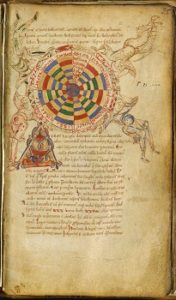An Interpretation on Hercules-Cacus Episode
Taro Yamashita
Summary
In Aen. 8.190-267 Evander narrates Hercules’ victory over Cacus, in which we find a poetic technique called ecphrasis. The parallel in Book 1 (453-493), Book 6 (679-892 ), and Book 8 (626 728), where the same technique is employed, is confirmed by the verbal correspondences found at 8. 306-312, which precedes another mythical episode about the Saturnian golden age.
These two myths, coupled as one, make a symmetrical construction as follows.
Myth (A): Hercules-Cacus Episode
1. present event: ceremonies at the Ara Maxima (184-189)
2. past event: Hercules-Cacus Episode (190-267)
3. present event: ceremonies at the Ara Maxima (268-305)
Introduction of Myth (B) (306-312)
Myth (B): Saturnian Golden Age
1. past event: Saturnian Golden Age (313-336)
2. future event: Augustan Rome (337-350)
3. past event: Saturnian Golden Age (351-358)
Myth (A): Evander mentions Hercules (359-369)
The central part (306-312) contains significant expressions (310 miratur, 311 capiturque, 310 facilis oculos fert omnia circum, 311 singula, 311 laetus) suggesting Virgil’s sense of history, which I examined fully in my previous paper (cf. Virgil’s Description of History: The Interpretation of Aeneid 6, Classical Studies 11, 1994, 118-135).
The analysis of Myths (A) and (B) clearly shows that Virgil implies this sense of history intentionally with the motif of future Rome. In Hercules-Cacus Episode, for instance, Virgil introduces aetiology to link mythical past with the Roman future. Evander explains the origin of the ruined cave on the Aventine (=mythical past) but he also predicts that the altar will be called Mightiest ever after (cf. 271-2 quae maxima semper/dicetur nobis et eris quae maxima semper). Augustan readers feel quite sure that this prediction has turned out true, and will be applicable to the future generation. Virgil, linking the mythical events to the historical incidents, tries to describe the past, the present, and the future of Rome.

